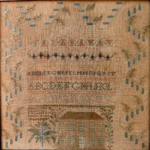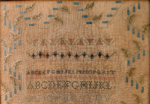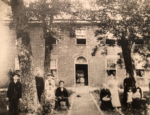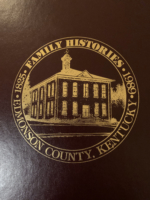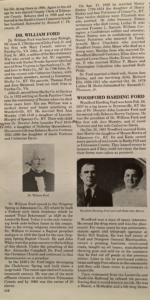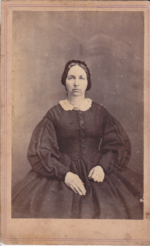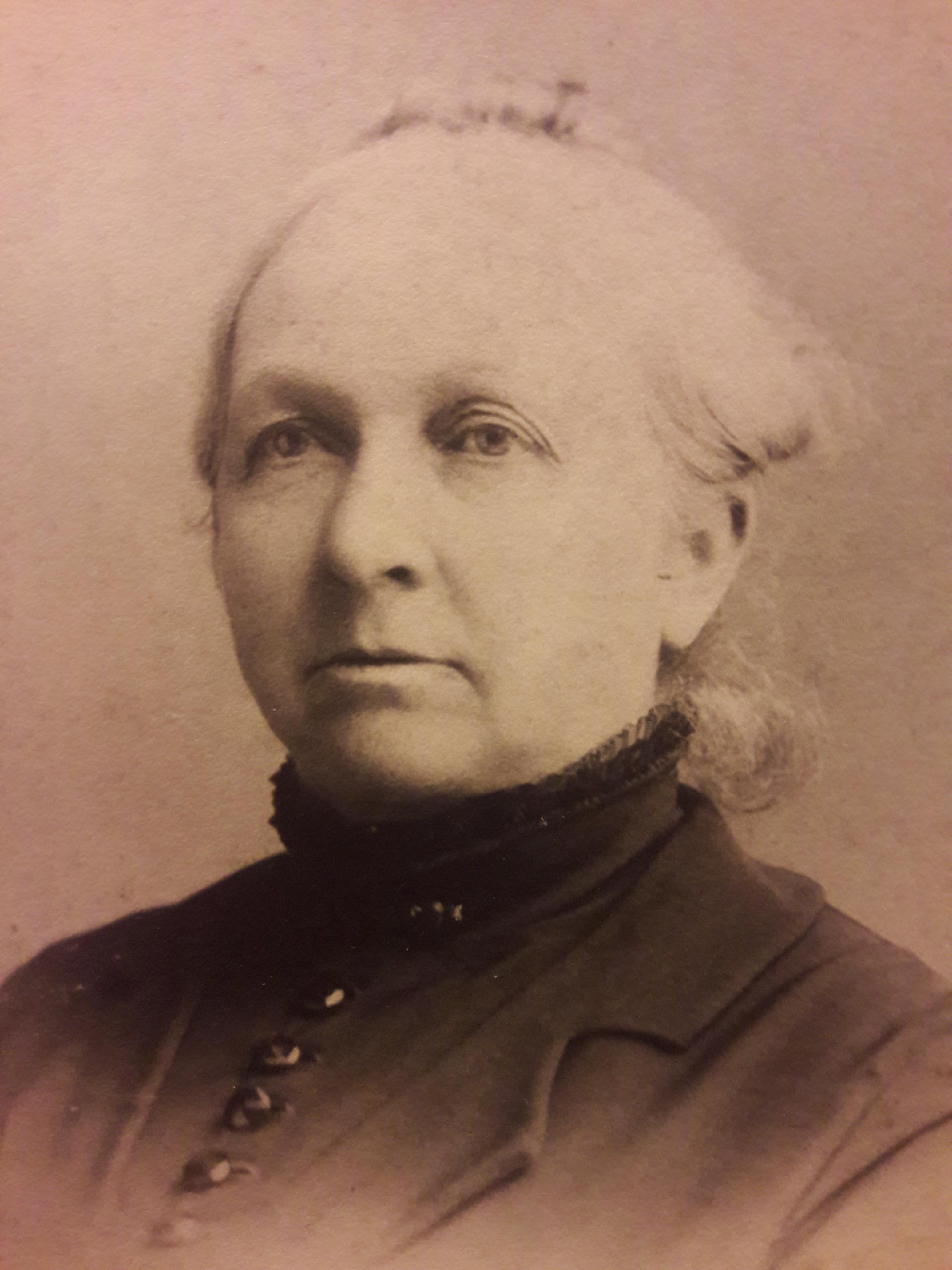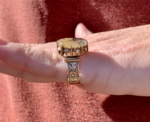Sampler
Maker's Name
Ford, Mary Charlotte
Location
Edmonson County, Kentucky
Date Made
1843
Maker's Age
11 years old, born January 7, 1832
Dimensions
27 ⅝ x 24 ⅜ inches
Medium
Silk on linen with Algerian eye, cross, four-sided, and queen stitches; thread count: 24/inch horizontal, 24/inch vertical
Provenance
The sampler was made by Mary Charlotte Ford in 1843. As best as can be determined, the sampler descended to Mary Charlotte’s son Luther Ford Dunn (1852-1886), who married Mattie Winston Hall (1856-1899), then to their child Woodford Hall Dunn (1884-1945), who married Louise Hamilton (1890-1938), then to their daughter Mary Louise Dunn (1913-2013), who married Burton Wilks Glover (1910-1960), then to their grandchild, Private Collector #31, who is the great, great, great, grandchild of the sampler maker. Private Collector #31 occasionally wears an agate ring, which by family history, was owned and worn by the sampler maker. (Please see the suggested descent and images of the ring in the ancillary images.)
Description
The sampler has six rows of alphabets and numbers separated by ornate, decorative crossbands. Below the rows of alphabets and crossbands is the signature:
Worked by Mary
Charlotte Ford.
Pt Retirement Ky
February 18 1843
The sampler has a very large, interesting, and unique border consisting of a simple vine, fronds, and unusual, identical, blue motifs of uncertain etiology (possibly very stylized grape bunches versus wisteria) attached to the simple vines. To the right of this verse is a home with a green lawn flanked by vines with flowers and an adjacent tree. The home is that of Mary Charlotte’s parents, William Ford, MD, and Nancy Ann Embry Ford. A current image of the home on U.S. Route 31W is seen in the ancillary images. The next ancillary image shows the home late in Charlotte's life. From left to right are Billy Diamond "William" Dunn, William Henry Dunn, Artimissia Mittie Dunn, Woodford Mason Dunn, (the walkway), Mary Charlotte Ford Dunn, Ermine Alice Dunn, Eliza "Lite" Embry, Anna Mae Dunn, and Martha Mattie W. Hall. An excellent discussion about the home is found in an article written by Ken Thomson and Joseph Stephen Hays for the book Edmonson County Kentucky Family Histories in 1988. A portion of that article is quoted below (sans the pictures which can be seen in the ancillary images) given the historical significance of the home and the Ford family. In the article there is reference to the home being illustrated in Nancy P. Ford’s sampler. This was in error. The Ford home at Pt (Point) Retirement is actually well demonstrated in Mary Charlotte’s sampler while it is unclear what home is represented in Nancy P. Ford’s sampler. AKS is indebted to Private Collector #27 for providing AKS with the below information:
_________________________________________________________________
“Point* Retirement”
“On Edmonson County's southern border and fronting on the Louisville Road is the beautiful Federal style brick house erected in 1828 for Dr. William Ford and his second wife Nancy Embry. They called it Point Retirement and fifteen years later the name was recorded for posterity when it was sewn into a sampler created by their daughter Nancy Patterson Ford.
This structure is indeed the most important house both historically and architecturally in Edmonson County and is today the only remaining ante-bellum brick dwelling in the county. Due to its qualifications in 1980 it was nominated and placed on the Register of Historic Places and is now designated as a National Historic Landmark.
William and Nancy Ford purchased the original tract of 350 acres on 3 February 1827 from Charles Epperson of Warren County, Kentucky for $740 with its appurtenances bounded by the lands of Ephraim Hubbard and the Morris Claim. They immediately began construction of their two-story house of brick laid in the Flemish bond pattern with wooden lintels in the bull's eye design over the windows and the typical eliptical fanlite over the front door.
A two room wooden ell was constructed and attached to the right rear of the brick portion housing the dining room on the first floor with an additional bed chamber above. All millwork was of native yellow poplar with floors of ash on the first level and floors of poplar on the second level.
Upon entering the central hall, we find a parlor to the left and the master bed chamber to the right. The bull's eye and rope motifs are found throughout the house in the Adam style. The front stairway lead to a trunk room over the entrance hall and a bed chamber for the boys over the parlor. A back stairway led to the girls’ bed chamber over the master bed chamber and also leading to the bed chamber over the dining room. All rooms except the parlor had built-in closets.
A separate kitchen, slave houses, meat house, carriage house and other dependencies are now gone. A short distance northeast of the mansion is found the family burying ground situated on one acre of land reserved by the Ford heirs.
When Dr. William Ford died 26 September 1860 his son-in-law, H. Tandy Arnold, sold “POINT* RETIREMENT” to his daughter Mary Charlotte (Ford) Dunn and her husband Woodford Dunn 19 November 1860 for the sum of $9000. Their ownership lasted until 1 January 1868 when they sold 538 acres for $9750 to Robert Smith Palmore and his wife Mary Elizabeth Wilson of neighboring Hart County.”
_________________________________________________________________
Given the very similar embroidery techniques, similar size of the samplers, very similar manner in which the samplers are nailed to wood backing and the close proximity of the Allen and Ford plantations, the findings strongly suggest that Catherine Allen, Mary Charlotte Ford, and Mary Charlotte’s sister, Nancy P. Ford, all attended the same school and were taught by the same teacher, possibly the “SJP” seen on Nancy’s sampler, but this is without proof. The most difficult stitch to execute on a sampler is the queen stitch and it is usually worked over four threads by four threads. Nancy exhibited her exemplary embroidery skills by working her queen stitches over eighteen threads by eighteen threads while Mary Charlotte's and Catherine Allen's queen stitches were over eight threads by eight threads. The school that the Ford sisters and Catherine Allen attended is also a matter of conjecture. From Jennie Coles' manuscript titled "The Oakland Country" written in 1941, a promising hypothesis is suggested. She describes a school in the Smiths Grove community called “Pleasant Hill” which was on the property of Moses Shobe (house still standing), whose farm adjoined the farm of William Allen (see the AKS entry on Catherine Allen). This school was active as early as the 1850s. The 1850 census indicates that it was in operation at that time with a teacher named James H. Jones, (twenty-five years of age) boarding in the home of Moses Shobe.
From page seven (7) of Ms. Cole’s manuscript is the following:
“Down the highway from the Luther M. Shobe home once stood the Pleasant Hill Christian Church which was built in an early day. The Shobes, Allens, Tuckers, Fords and others were members of this church. In 1873 the organization built the first church in Oakland and moved their membership there. On the same hill as the church stood the Pleasant Hill school which was an important school before the public schools were established. The building consisted of several rooms but a Masonic Lodge occupied part of the second floor. Boys and girls from a distance boarded in the homes of the community and attended this school. They usually had four teachers including a music teacher.” Again, AKS acknowledges that this is conjecture, albeit an intriguing one. Alternatively, Lynne Anderson, PhD has suggested to AKS that given the wealth of the Fords and Allens, they may have hired a teacher from elsewhere to live with the family for a period of time giving personal instruction to the girls.
Mary Charlotte “Lottie” Ford was born on January 7, 1832, in Dripping Springs, Edmonson County, Kentucky at “Pt (Point) Retirement” Plantation. Her father William Ford, MD, (1794-1860), was thirty-eight years old and her mother, Nancy Ann Embry (1799-1854), was thirty-three. (Please see the entry for Dr. Ford in the "Family Histories Edmonson County, Kentucky" book in the below ancillary images.) Nancy Ann Embry (b.1799-d.1854, m. 04-17-1820) was the second of William Ford’s three wives (first wife was Ann Murphy, b.1799-d.1819, with one offspring and his third wife was Susan Ann Kirtley, b.1831-d.1915, m. 2-2-1857 with one offspring resulting from this union as well).
In addition to these two half siblings, Mary Charlotte "Lottie" Ford had five full brothers and six full sisters including Ermine Artimissia "Mittie” Ford, (1821-1840), Elizabeth Ann "Lizzie" Ford (1821-1898), Henry Embry Ford (ca. 1823-?), Luther R. Ford (ca. 1826-1865), William Covington Ford (1828-?), Nancy Patterson Ford (1829-1901), Martha Jane Ford (1835-1892), John Miner Ford (1836-1856), Ellen Alice Ford (1838-1918), Ermine Artimissia Ford (1840-1906) and Christopher Columbus Ford (1842-?).
Smith's Grove and Dripping Spring were not towns, villages, or even hamlets. They were established Post Offices only. The Allens, at their Pleasant Retirement plantation, (see AKS sampler maker Catherine Allen), and the Fords (at their Point Retirement plantation) lived in the country on a major thoroughfare that went by “The Big Road”, “New Orleans Trace”, “Lexington Road” as well as other names... even “Natchez Trace”. The two plantations were only several miles apart. In 1829 the Louisville & Nashville Turnpike was authorized by the state legislature and construction of a cobblestone road with tolls every five miles was begun. Smith's Grove P.O. was established in 1829 and Dripping Spring P.O. was established in 1828. They were about three miles apart in the beginning and both families got mail at both places. The Fords and the Allens lived in between the two post offices. When the railroad came through in 1859, Dripping Springs was moved to the railroad and renamed Rocky Hill Station. Smiths Grove which by that time had moved several places, also moved to the railroad and kept its name.
Mary Charlotte Ford (see the ca.1870 photo of Mary Charlotte in the ancillary images) married Woodford Mason Dunn (1824-1898) of Smiths Grove, Warren County, Kentucky on September 11, 1849, at her parents’ home, Point Retirement, Dripping Spring, Edmonson County, Kentucky. (Please see a wedding photo of Woodford Mason Dunn and Mary Charlotte Ford Dunn in the ancillary images.) Their children included William Henry (1850-1912), Luther Ford (1852-1886), Nancy Embry (1854-1930), George H. W. (1856-1919), Eliza Embry (“Liza”) (1857-1940), Artemesia (1860-1933), Ermine Alice (1862-1935) and William “Billy” Diamond (1871-1937). Prior to 1862 Mary Charlotte and Woodford Mason Dunn were living in Warren County, Kentucky. The birth certificates of Ermine Alice (1862) and William Diamond (1871) show the family had removed to Castalian Springs, Sumner County, Tennessee (just south of the Kentucky-Tennessee border) by 1862. Ancestry.com suggests that a Woodford Dunn, fought for the Union as a Private in the U.S. Colored Troops during the Civil War (enlisted January 14, 1865). Whether this is Woodford Mason Dunn or not is questioned by AKS.
Mary Charlotte “Lottie” Ford died in Castalian Springs, Sumner County, Tennessee on August 26, 1915. She is buried there with her husband in the Morgan Cemetery.
AKS is most grateful to a prominent Warren County, Kentucky historian, (AKS Private Collector #27), for significant portions of the above historical record. Likewise, he has graciously supplied AKS the image of the original carte-de-visite of Mary Charlotte Ford Dunn which was made about 1870, as well as the other ancillary images.
Worked by Mary
Charlotte Ford.
Pt Retirement Ky
February 18 1843
The sampler has a very large, interesting, and unique border consisting of a simple vine, fronds, and unusual, identical, blue motifs of uncertain etiology (possibly very stylized grape bunches versus wisteria) attached to the simple vines. To the right of this verse is a home with a green lawn flanked by vines with flowers and an adjacent tree. The home is that of Mary Charlotte’s parents, William Ford, MD, and Nancy Ann Embry Ford. A current image of the home on U.S. Route 31W is seen in the ancillary images. The next ancillary image shows the home late in Charlotte's life. From left to right are Billy Diamond "William" Dunn, William Henry Dunn, Artimissia Mittie Dunn, Woodford Mason Dunn, (the walkway), Mary Charlotte Ford Dunn, Ermine Alice Dunn, Eliza "Lite" Embry, Anna Mae Dunn, and Martha Mattie W. Hall. An excellent discussion about the home is found in an article written by Ken Thomson and Joseph Stephen Hays for the book Edmonson County Kentucky Family Histories in 1988. A portion of that article is quoted below (sans the pictures which can be seen in the ancillary images) given the historical significance of the home and the Ford family. In the article there is reference to the home being illustrated in Nancy P. Ford’s sampler. This was in error. The Ford home at Pt (Point) Retirement is actually well demonstrated in Mary Charlotte’s sampler while it is unclear what home is represented in Nancy P. Ford’s sampler. AKS is indebted to Private Collector #27 for providing AKS with the below information:
_________________________________________________________________
“Point* Retirement”
“On Edmonson County's southern border and fronting on the Louisville Road is the beautiful Federal style brick house erected in 1828 for Dr. William Ford and his second wife Nancy Embry. They called it Point Retirement and fifteen years later the name was recorded for posterity when it was sewn into a sampler created by their daughter Nancy Patterson Ford.
This structure is indeed the most important house both historically and architecturally in Edmonson County and is today the only remaining ante-bellum brick dwelling in the county. Due to its qualifications in 1980 it was nominated and placed on the Register of Historic Places and is now designated as a National Historic Landmark.
William and Nancy Ford purchased the original tract of 350 acres on 3 February 1827 from Charles Epperson of Warren County, Kentucky for $740 with its appurtenances bounded by the lands of Ephraim Hubbard and the Morris Claim. They immediately began construction of their two-story house of brick laid in the Flemish bond pattern with wooden lintels in the bull's eye design over the windows and the typical eliptical fanlite over the front door.
A two room wooden ell was constructed and attached to the right rear of the brick portion housing the dining room on the first floor with an additional bed chamber above. All millwork was of native yellow poplar with floors of ash on the first level and floors of poplar on the second level.
Upon entering the central hall, we find a parlor to the left and the master bed chamber to the right. The bull's eye and rope motifs are found throughout the house in the Adam style. The front stairway lead to a trunk room over the entrance hall and a bed chamber for the boys over the parlor. A back stairway led to the girls’ bed chamber over the master bed chamber and also leading to the bed chamber over the dining room. All rooms except the parlor had built-in closets.
A separate kitchen, slave houses, meat house, carriage house and other dependencies are now gone. A short distance northeast of the mansion is found the family burying ground situated on one acre of land reserved by the Ford heirs.
When Dr. William Ford died 26 September 1860 his son-in-law, H. Tandy Arnold, sold “POINT* RETIREMENT” to his daughter Mary Charlotte (Ford) Dunn and her husband Woodford Dunn 19 November 1860 for the sum of $9000. Their ownership lasted until 1 January 1868 when they sold 538 acres for $9750 to Robert Smith Palmore and his wife Mary Elizabeth Wilson of neighboring Hart County.”
_________________________________________________________________
Given the very similar embroidery techniques, similar size of the samplers, very similar manner in which the samplers are nailed to wood backing and the close proximity of the Allen and Ford plantations, the findings strongly suggest that Catherine Allen, Mary Charlotte Ford, and Mary Charlotte’s sister, Nancy P. Ford, all attended the same school and were taught by the same teacher, possibly the “SJP” seen on Nancy’s sampler, but this is without proof. The most difficult stitch to execute on a sampler is the queen stitch and it is usually worked over four threads by four threads. Nancy exhibited her exemplary embroidery skills by working her queen stitches over eighteen threads by eighteen threads while Mary Charlotte's and Catherine Allen's queen stitches were over eight threads by eight threads. The school that the Ford sisters and Catherine Allen attended is also a matter of conjecture. From Jennie Coles' manuscript titled "The Oakland Country" written in 1941, a promising hypothesis is suggested. She describes a school in the Smiths Grove community called “Pleasant Hill” which was on the property of Moses Shobe (house still standing), whose farm adjoined the farm of William Allen (see the AKS entry on Catherine Allen). This school was active as early as the 1850s. The 1850 census indicates that it was in operation at that time with a teacher named James H. Jones, (twenty-five years of age) boarding in the home of Moses Shobe.
From page seven (7) of Ms. Cole’s manuscript is the following:
“Down the highway from the Luther M. Shobe home once stood the Pleasant Hill Christian Church which was built in an early day. The Shobes, Allens, Tuckers, Fords and others were members of this church. In 1873 the organization built the first church in Oakland and moved their membership there. On the same hill as the church stood the Pleasant Hill school which was an important school before the public schools were established. The building consisted of several rooms but a Masonic Lodge occupied part of the second floor. Boys and girls from a distance boarded in the homes of the community and attended this school. They usually had four teachers including a music teacher.” Again, AKS acknowledges that this is conjecture, albeit an intriguing one. Alternatively, Lynne Anderson, PhD has suggested to AKS that given the wealth of the Fords and Allens, they may have hired a teacher from elsewhere to live with the family for a period of time giving personal instruction to the girls.
Mary Charlotte “Lottie” Ford was born on January 7, 1832, in Dripping Springs, Edmonson County, Kentucky at “Pt (Point) Retirement” Plantation. Her father William Ford, MD, (1794-1860), was thirty-eight years old and her mother, Nancy Ann Embry (1799-1854), was thirty-three. (Please see the entry for Dr. Ford in the "Family Histories Edmonson County, Kentucky" book in the below ancillary images.) Nancy Ann Embry (b.1799-d.1854, m. 04-17-1820) was the second of William Ford’s three wives (first wife was Ann Murphy, b.1799-d.1819, with one offspring and his third wife was Susan Ann Kirtley, b.1831-d.1915, m. 2-2-1857 with one offspring resulting from this union as well).
In addition to these two half siblings, Mary Charlotte "Lottie" Ford had five full brothers and six full sisters including Ermine Artimissia "Mittie” Ford, (1821-1840), Elizabeth Ann "Lizzie" Ford (1821-1898), Henry Embry Ford (ca. 1823-?), Luther R. Ford (ca. 1826-1865), William Covington Ford (1828-?), Nancy Patterson Ford (1829-1901), Martha Jane Ford (1835-1892), John Miner Ford (1836-1856), Ellen Alice Ford (1838-1918), Ermine Artimissia Ford (1840-1906) and Christopher Columbus Ford (1842-?).
Smith's Grove and Dripping Spring were not towns, villages, or even hamlets. They were established Post Offices only. The Allens, at their Pleasant Retirement plantation, (see AKS sampler maker Catherine Allen), and the Fords (at their Point Retirement plantation) lived in the country on a major thoroughfare that went by “The Big Road”, “New Orleans Trace”, “Lexington Road” as well as other names... even “Natchez Trace”. The two plantations were only several miles apart. In 1829 the Louisville & Nashville Turnpike was authorized by the state legislature and construction of a cobblestone road with tolls every five miles was begun. Smith's Grove P.O. was established in 1829 and Dripping Spring P.O. was established in 1828. They were about three miles apart in the beginning and both families got mail at both places. The Fords and the Allens lived in between the two post offices. When the railroad came through in 1859, Dripping Springs was moved to the railroad and renamed Rocky Hill Station. Smiths Grove which by that time had moved several places, also moved to the railroad and kept its name.
Mary Charlotte Ford (see the ca.1870 photo of Mary Charlotte in the ancillary images) married Woodford Mason Dunn (1824-1898) of Smiths Grove, Warren County, Kentucky on September 11, 1849, at her parents’ home, Point Retirement, Dripping Spring, Edmonson County, Kentucky. (Please see a wedding photo of Woodford Mason Dunn and Mary Charlotte Ford Dunn in the ancillary images.) Their children included William Henry (1850-1912), Luther Ford (1852-1886), Nancy Embry (1854-1930), George H. W. (1856-1919), Eliza Embry (“Liza”) (1857-1940), Artemesia (1860-1933), Ermine Alice (1862-1935) and William “Billy” Diamond (1871-1937). Prior to 1862 Mary Charlotte and Woodford Mason Dunn were living in Warren County, Kentucky. The birth certificates of Ermine Alice (1862) and William Diamond (1871) show the family had removed to Castalian Springs, Sumner County, Tennessee (just south of the Kentucky-Tennessee border) by 1862. Ancestry.com suggests that a Woodford Dunn, fought for the Union as a Private in the U.S. Colored Troops during the Civil War (enlisted January 14, 1865). Whether this is Woodford Mason Dunn or not is questioned by AKS.
Mary Charlotte “Lottie” Ford died in Castalian Springs, Sumner County, Tennessee on August 26, 1915. She is buried there with her husband in the Morgan Cemetery.
AKS is most grateful to a prominent Warren County, Kentucky historian, (AKS Private Collector #27), for significant portions of the above historical record. Likewise, he has graciously supplied AKS the image of the original carte-de-visite of Mary Charlotte Ford Dunn which was made about 1870, as well as the other ancillary images.
Owner/History of Owner/Credit Line
Private Collector #31
AKS Catalog Number
2020-080
Sources
"Family Histories Edmonson County, Kentucky, 1825-1989”,
Published, 1989 by Turner Pub. Co., Paducah, Kentucky
Prepared by the Edmonson County Historical Society.
Private Collector #27
Historicplaces.net
Npgallery.nps.gov
“Our Heritage, An Album of Early Warren County Kentucky Land Marks” by Irene Moss Sumpter, 1991
Ancestry.com
Findagrave.com
Genealogy & notes supplied by Private Collector #31
FamilySearch.org
Published, 1989 by Turner Pub. Co., Paducah, Kentucky
Prepared by the Edmonson County Historical Society.
Private Collector #27
Historicplaces.net
Npgallery.nps.gov
“Our Heritage, An Album of Early Warren County Kentucky Land Marks” by Irene Moss Sumpter, 1991
Ancestry.com
Findagrave.com
Genealogy & notes supplied by Private Collector #31
FamilySearch.org
Explore Sampler

